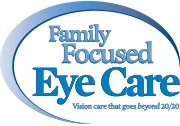Different Kinds of Lenses
Glasses lenses are available in several different styles, materials, and designs. Our goal is to help you understand the differences between lenses so that you can find the perfect lens type to fit your vision needs.
- Single Vision
- Multifocal Lenses
- Progressive Additional lenses
- Occupational and Recreational Lenses
- Lens Design
Single Vision
Single vision lenses have the same optical correction over the entire area of the lens. These are primarily used to treat nearsightedness and farsightedness. Most non-presbyopic wearers will need single vision lenses for their visual needs.
Multifocal Lenses
Bifocal and Trifocal lenses have visible lines that define separation of prescriptions found in the lens. When wearing a bifocal lens, you will use your distance vision in the top part of the lenses, and use near vision in the lower part of the lens. The trifocal lens has three focal distances. The third focal distance, placed in the middle of the lens, is utilized for viewing intermediate distances that are not covered by the top or bottom sections.
Progressive Lenses
Progressive lenses offer a smooth transition from distance vision found at the top of the lens through near vision at the bottom. These lenses provide you with a full range of vision so that you can see any distance. The great thing about these lenses is that they don’t have any visible lines on the lenses to show the different prescriptions. This offers better aesthetics than classic bifocal lenses. These are the lenses of choice to treat presbyopia. Hundreds of different progressive styles exist and we are more then happy to educate you on which particular style would be best for your prescription.
Occupational Lenses
Essilor Computer Lens
The Essilor Computer Lens is a great occupational lens for those of us that spend a large portion of our time in front of a computer screen. It has the same design as a progressive lens, but provides a larger intermediate area to help with computer or other intermediate ranged tasks. The great thing about the lens is that it allows the wearer to see from close up to across the office or room. In addition, this lens comes with a Blue-Violet light blocker to help with computer eye strain and fatigue.
Essilor Eyezen
Eyezen lenses are designed to enhance the digital world that we currently live in. Did you know that more than 90% of adults are at risk from digital eye strain? These lenses come with a blue light filter to help protect your eyes from harmful Blue-Violet light. In addition, they provide a small boost in reading power at the lower portion of the lenses. This design allows our eyes to relax when we are using electronic devices so that we can reduce eye strain caused by using our phone, tablets, or other similar objects. The great thing about these lenses is that you don’t even need a prescription to get them. They come in a non-prescription form to help those who need to reduce eye strain, but don’t need vision correction.
Lens Shape
I’m sure you wonder what your glasses lenses are going to look like when they are done. If you have a minus prescription, your glasses are going to be thickest around the border. The opposite is true when you have a plus prescription which have the thickest point in the center. The higher your prescription the thicker your lenses would get, however, we can use specific lens materials to avoid thick lenses. These materials include CR-39 Plastic, Polycarbonate, Trivex, and an assortment of high index lenses. We will work with you and your prescription to discover which lens material will be best for your prescription.
If you have questions about lenses, give us a call at our office: (801) 302-3080. We would be happy to assist you in whatever you need.
